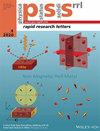氮化铝的深紫外发光特性
IF 2.5
4区 物理与天体物理
Q3 MATERIALS SCIENCE, MULTIDISCIPLINARY
引用次数: 0
摘要
利用波长可调的高重复率激光器,对无意掺杂、掺硅和掺镁的同向外延氮化铝(AlN)薄膜进行了高分辨率、低激发光致发光(PL)光谱分析。波长可调激光器用于区分氮化铝的发光和散射信号。通过提供高分辨率、低激发聚光光谱,回顾了目前对氮化铝深紫外发光特性的理解,并讨论了未知发光线和发光带的潜在归属。尽管之前的研究已经就一些发射峰和发射带的起源达成了共识,如中性硅供体结合激子跃迁和涉及纵向光学声子的自由激子跃迁,但研究表明,许多发射峰仍未确定。应阐明所有发射峰的起源,以便控制氮化铝的电子和光电特性。本文受版权保护。本文章由计算机程序翻译,如有差异,请以英文原文为准。
Deep‐ultraviolet luminescence properties of AlN
High‐resolution, low‐excitation photoluminescence (PL) spectroscopy was performed for unintentionally doped, silicon‐doped, and magnesium‐doped homoepitaxial aluminum nitride (AlN) films, using a wavelength‐tunable high‐repetition‐rate laser. The wavelength‐tunable laser was used to distinguish between the luminescence and scattering signals from AlN. Providing the high‐resolution, low‐excitation PL spectra, the current understanding of the deep‐ultraviolet luminescence properties of AlN is reviewed and potential assignments for the unknown luminescence lines and bands are discussed. Although previous studies have led to a consensus on the origins of some emission peaks and bands such as the neutral silicon donor‐bound exciton transition and free exciton transitions involving longitudinal optical phonons, it is shown that many of the emission peaks are still unidentified. The origins of all the emission peaks should be elucidated to enable control of the electronic and optoelectronic properties of AlN.This article is protected by copyright. All rights reserved.
求助全文
通过发布文献求助,成功后即可免费获取论文全文。
去求助
来源期刊

Physica Status Solidi-Rapid Research Letters
物理-材料科学:综合
CiteScore
5.20
自引率
3.60%
发文量
208
审稿时长
1.4 months
期刊介绍:
Physica status solidi (RRL) - Rapid Research Letters was designed to offer extremely fast publication times and is currently one of the fastest double peer-reviewed publication media in solid state and materials physics. Average times are 11 days from submission to first editorial decision, and 12 days from acceptance to online publication. It communicates important findings with a high degree of novelty and need for express publication, as well as other results of immediate interest to the solid-state physics and materials science community. Published Letters require approval by at least two independent reviewers.
The journal covers topics such as preparation, structure and simulation of advanced materials, theoretical and experimental investigations of the atomistic and electronic structure, optical, magnetic, superconducting, ferroelectric and other properties of solids, nanostructures and low-dimensional systems as well as device applications. Rapid Research Letters particularly invites papers from interdisciplinary and emerging new areas of research.
 求助内容:
求助内容: 应助结果提醒方式:
应助结果提醒方式:


